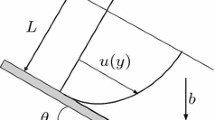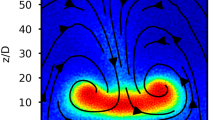Abstract
The complete thermodynamically consistent turbulent closure models of isochoric and isothermal dry granular dense flows with incompressible grains and weak turbulent intensity are established on the basis of a linearized theory with respect to the granular coldness for the dynamic responses of the closure conditions. The models are applied to study a gravity-driven stationary turbulent flow down an inclined moving plane, and the numerical simulations are compared with the experimental outcomes. It shows that while the mean velocity decreases monotonically from its boundary value on the moving plane toward the free surface, the mean porosity and granular coldness display more “exponential-like” increasing/decreasing tendencies. Of particular interest is that the granular coldness evolves from its maximum value on the moving plane toward its minimum value on the free surface, leading to the turbulent dissipation evolving in a similar manner, while the turbulent kinetic energy demonstrate a reverse tendency. The obtained results show good agreements to the experimental outcomes and are similar to the characteristics of conventional Newtonian fluids in turbulent shear flows.







Similar content being viewed by others
Notes
\({\varvec{\varPhi }}\) should be homogeneous of the first degree of \({\varvec{D}}\) and is originally assigned to the Cauchy stress \({\varvec{t}}\). However, in our formulations, this concept is extended for the internal friction \({\varvec{Z}}\) and the mean production \(\bar{{\varvec{\varPhi }}}\) in turbulent flows.
In the previous works, only the no-slip conditions for the velocity and the fixed value of the mean volume fraction on the moving plane are employed, and that the solid boundary behaves as an energy source/sink of the turbulent kinetic energy is not taken into account, even the flow is obviously turbulent, e.g., see [14, 15, 30, 43, 44]. This goes back to the laminar flow formulations. In the present study, the solid boundary as an energy source/sink is taken into account by prescribing the boundary values of \(\vartheta ^T\) on the moving plane.
References
Ahmadi G (1985) A turbulence model for rapid flows of granular materials. Part I. Basic theory. Powder Technol 44:261–268
Ahmadi G, Shahinpoor M (1983) Towards a turbulent modeling of rapid flow of granular materials. Powder Technol 35:241–248
Ai J, Langston PA, Yu H-S (2014) Discrete element modeling of material non-coaxiality in simple shear flows. Int J Numer Anal Meth Geomech 38:615–635
Aranson IS, Tsimring LS (2009) Granular patterns. Oxford University Press, Oxford
Aste T, Matteo TD, Tordesillas A (eds) (2007) Granular and complex materials. World Scientific Publishing, Singapore
Bagnold RA (1954) Experiments on a gravity free dispersion of large solid spheres in a Newtonian fluid under shear. Proc R Soc Lond A 225:49–63
Batchelor GK (1993) The theory of homogeneous turbulence. Cambridge University Press, Cambridge
Bauer E, Herle I (2000) Stationary states in hypoplasticity. In: Kolymbas D (ed) Constitutive modeling of granular materials. Springer, Berlin, pp 167–192
Bradshaw P (1971) An introduction to turbulence and its measurement. Pergamon Press, Oxford
Buscamera G (2014) Uniqueness and existence in plastic models for unsaturated soils. Acta Geotechnica 9:313–327
Duran J (2000) Sands, powders and grains. Springer, Wien
Fang C (2008) Modeling dry granular mass flows as elasto-visco-hypoplastic continua with microstructural effects. I. Thermodynamically consistent constitutive model. Acta Mech 197(3–4):173–189
Fang C (2008) Modeling dry granular mass flows as elasto-visco-hypoplastic continua with microstructural effects. II. Numerical simulations of benchmark flow problems. Acta Mech 197(3–4):191–209
Fang C (2009) Gravity-driven dry granular slow flows down an inclined moving plane: a comparative study between two concepts of the evolution of porosity. Rheol Acta 48:971–992
Fang C (2010) Rheological characteristics of solid-fluid transition in dry granular dense flows: a thermodynamically consistent constitutive model with a pressure-ratio order parameter. Int J Numer Anal Meth Geomech 34:881–905
Fang C, Wang Y, Hutter K (2006) Shearing flows of a dry granular material—hypoplastic constitutive theory and numerical simulations. Int J Numer Anal Meth Geomech 30:1409–1437
Fang C, Wang Y, Hutter K (2006) A thermo-mechanical continuum theory with internal length for cohesionless granular materials. Part I. A class of constitutive models. Continuum Mech Thermodyn 17(8):545–576
Fang C, Wang Y, Hutter K (2006) A thermo-mechanical continuum theory with internal length for cohesionless granular materials. Part II. Non-equilibrium postulates and numerical simulations of simple shear, plane Poiseuille and gravity driven problems. Continuum Mech Thermodyn 17(8):577–607
Fang C, Wu W (2014) On the weak turbulent motions of an isothermal dry granular dense flow with incompressible grains. Part I. Equilibrium turbulence closure models. Acta Geotech. doi:10.1007/S11440-014-0313-4
Fellin W (2013) Extension to barodesy to model void ratio and stress dependency of the \(\text{K}_0\) value. Acta Geotechnica 8:561–565
Fuentes W, Triantaftllidis T, Lizcano A (2012) Hypoplastic model for sands with loading surface. Acta Geotechnica 7(3):177–192
MiDi GDR (2004) On dense granular flows. Eur Phys J E 14:341–365
Goodman MA, Cowin SC (1971) Two problems in the gravity flow of granular materials. J Fluid Mech 45:321–339
Goodman MA, Cowin SC (1972) A continuum theory for granular materials. Arch Rational Mech Anal 44:249–266
Hanes DM, Inman D (1985) Observations of rapidly flowing granular-fluid materials. J Fluid Mech 150:357–380
Hanes DM, Jenkins JT, Richman MW (1988) The thickness of steady plane shear flow of circular disks driven by identical boundaries. J Appl Mech 55:969–980
Herle I, Gudehus G (1999) Determination of parameters of a hypoplastic constitutive model from properties of grain assemblies. Mech Cohes Frict Mater 4(5):461–485
Hinze JO (1975) Turbulence. McGraw-Hill, New York
Hui K, Haff PK, Ungar JE (1984) Boundary conditions for high-shear grain flows. J Fluid Mech 145:223–233
Kirchner N, Teufel A (2002) Thermodynamically consistent modeling of abrasive granular materials. II: thermodynamic equilibrium and applications to steady shear flows. Proc R Soc Lond A 458:3053–3077
Kolymbas D (1991) An outline of hypoplasticity. Arch Appl Mech 61:143–151
Kolymbas D (2000) Introduction to hypoplasticity. Balkema, Rotterdam
Lumley JL, Tennekes H (1972) A first course in turbulence. MIT Press, Cambridge
Ma D, Ahmadi G (1985) A turbulence model for rapid flows of granular materials. Part II. Simple shear flows. Powder Technol 44:269–279
Marcher Th, Vermeer PA, Wolffersdorf P-A (2000) Hypoplastic and elastoplastic modeling—a comparison with test data. In: Kolymbas D (ed) Constitutive modeling of granular materials. Springer, Berlin, pp 353–371
Oswald P (2009) Rheophysics: the deformation and flow of matter. Cambridge University Press, New York
Passman SL, Nunziato JW, Bailey PB et al (1980) Shearing flow of granular materials. J Eng Mech Div ASCE 106:773–783
Perng ATH, Capart H, Chou HT (2006) Granular configurations, motions, and correlations in slow uniform flows driven by an inclined conveyor belt. Gran Matter 8:5–17
Rao KK, Nott PR (2008) Introduction to granular flows. Cambridge University Press, London
Savage SB (1979) Gravity flow of cohesionless granular materials in chutes and channels. J Fluid Mech 92:53–96
Tanner RI (1992) Engineering rheology. Oxford University Press, New York
Tsinober A (2009) An informal conceptual introduction to turbulence. Springer, Heidelberg
Wang Y, Hutter K (1999) A constitutive theory of fluid-saturated granular materials and its application in gravitational flows. Rheol Acta 38:214–223
Wang Y, Hutter K (1999) Shearing flows in a Goodman-Cowin type granular material: theory and numerical results. Part Sci Technol 17:97–124
Wendt JF (ed) (2009) Computational fluid dynamics: an introduction. Springer, Berlin
Wu W, Kolymbas D (2000) Hypoplasticity then and now. In: Kolymbas D (ed) Constitutive modeling of granular materials. Springer, Berlin, pp 57–105
Acknowledgments
The authors are indebted to the National Science Council, Taiwan, for the financial support through the project NSC 101–2221–E–006–195–, and the reviewers and the editors for their comments and suggestions which led to improvements.
Author information
Authors and Affiliations
Corresponding author
Rights and permissions
About this article
Cite this article
Fang, C., Wu, W. On the weak turbulent motions of an isothermal dry granular dense flow with incompressible grains: part II. Complete closure models and numerical simulations. Acta Geotech. 9, 739–752 (2014). https://doi.org/10.1007/s11440-014-0314-3
Received:
Accepted:
Published:
Issue Date:
DOI: https://doi.org/10.1007/s11440-014-0314-3




